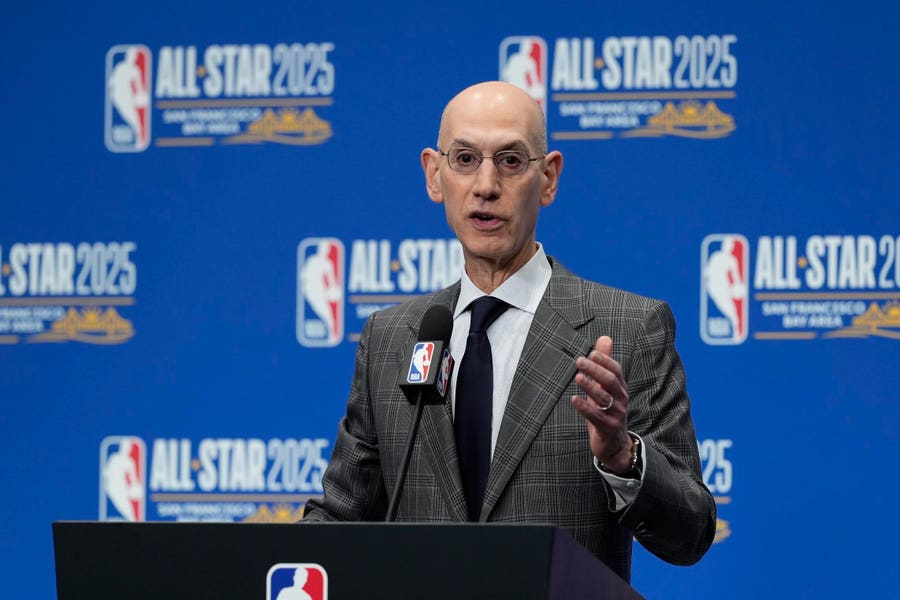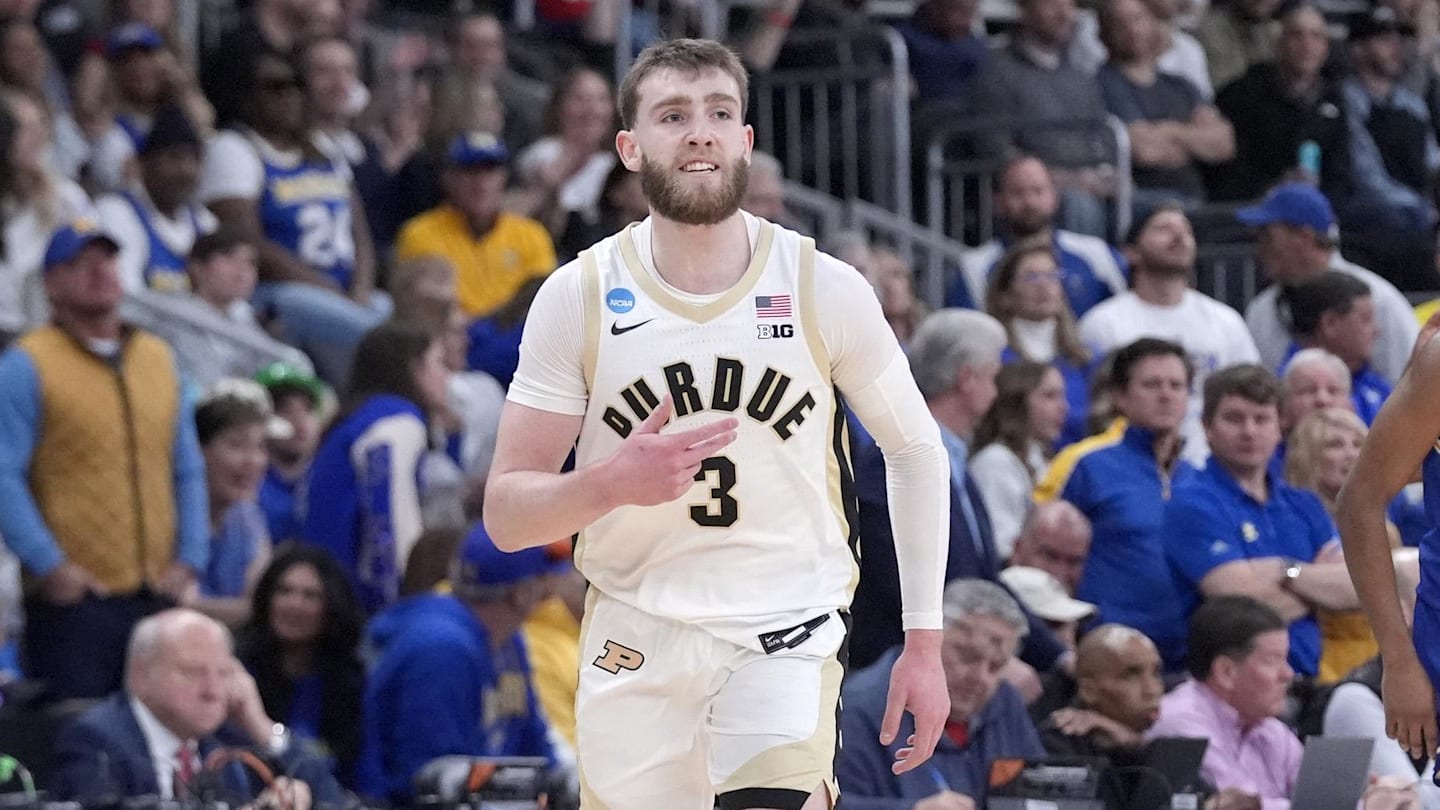
NBA Commissioner Adam Silver recently addressed the future of NBA expansion following a meeting of the board of governors. Silver reportedly stated that the league is carefully evaluating the recent sale of the Boston Celtics before moving forward with further expansion discussions. The Boston Celtics sold for $6.1 billion in March. (Back in December, Forbes valued the Celtics franchise at $6 billion.) With the NBA currently comprised of 30 teams, the inevitable question arises: Where should the league look to expand next? To answer this, I conducted an analysis that combines two critical factors: county population and county proximity to existing NBA teams. By assessing areas that are densely populated but relatively underserved by current franchises, this analysis aims to identify the most promising locations for future NBA expansion.
Methodology For Identifying NBA Expansion Cities
SALT LAKE CITY, UTAH – FEBRUARY 19: LeBron James #6 of the Los Angeles Lakers dunks during the first … More
Getty Images
Data
To identify potential NBA expansion cities, I utilized two primary datasets. The first dataset was county-level population estimates from the American Community Survey. The second was the geographic location of every NBA team.
NBA Expansion Score Computation
I developed a metric to compute the relative attractiveness of different counties for NBA expansion. This metric is a weighted and normalized combination of each county’s population and distance to existing NBA teams: For every county, I compared its population to all other counties on a scale of 0 to 1 where 0 represents a county with no population and 1 represents the highest population county in the country. Similarly, I compared its distance to existing NBA teams on a scale of 0 to 1 where 0 represents the exact location of an NBA stadium and 1 represents the furthest county in the country from an NBA stadium. I then formed an “NBA expansion score” by combining the two normalized metrics together with a weight of 0.75 for the population and 0.25 for the distance to an existing franchise.
Exclusion Criteria
To refine the analysis and focus on realistic expansion opportunities, I applied several exclusion criteria including removing counties:
- Within 50 miles of an existing NBA team to avoid overlap with established markets.
- With a population of less than 100,000 to avoid small markets.
- Outside the continental United States.
Comparing Metrics of NBA Expansion Candidates
Population
A map showing the population of US counties in millions. Lighter colors indicate higher populations.
Image created by author.
The most populous county in the United States is Los Angeles County, boasting a population of 9.75 million people. Other densely populated counties include Cook County (Chicago), Harris County (Houston), and Maricopa County (Phoenix), all of which currently have NBA franchises. The most populous county without an NBA team is San Diego County, with a population of 3.30 million. This highlights San Diego as a potentially attractive market for NBA expansion due to its large population base and absence of direct competition from an existing NBA team.
Distance To Existing NBA Teams
A map showing the distance to existing NBA franchises of US counties in miles. Lighter colors … More
Image created by author.
The counties most distant from existing NBA teams are primarily located in northwest North Dakota and northeast Montana. The most isolated county in the country is Burke County, North Dakota, which has a population of 2,154 and is situated 647 miles from the nearest NBA team, the Denver Nuggets. Among counties with a population of at least 100,000, the most remote is Flathead County, Montana. With a population of 114,527, Flathead County is located approximately 540 miles from the closest NBA team, the Utah Jazz.
Identifying Top NBA Expansion Candidates
Combining population metrics and proximity to existing NBA teams reveals some intriguing findings. After applying exclusion criteria and calculating the NBA Expansion Score, most of the promising candidates for new franchises are located in the western United States.
A map showing the counties with the best prospects for NBA expansion. Lighter colors indicate more … More
Image created by author.
Southern California
San Diego skyline at night. (Photo by Orjan F. Ellingvag/Dagbladet/Corbis via Getty Images)
Corbis via Getty Images
San Diego, Riverside, and San Bernadino Counties all emerge as some of the top candidates for NBA expansion. Notably, San Diego County is a high population county over 120 miles from the Los Angeles Clippers stadium in Inglewood. San Diego already has a basketball presence with the G League’s San Diego Clippers, a nod to the NBA franchise that previously called the city home from 1978 to 1984. Meanwhile, Riverside and San Bernardino Counties, while sizable, have never had an NBA team and are likely less attractive options compared to San Diego.
Las Vegas
LAS VEGAS, NEVADA – JANUARY 01: Fireworks illuminate the skyline over the Las Vegas Strip during an … More
Getty Images
The second most promising candidate for NBA expansion according to the model is Clark County, Nevada (Las Vegas). The city has been rapidly expanding its professional sports profile, starting with the NHL’s Vegas Golden Knights in 2017, and now includes the WNBA’s Las Vegas Aces, NFL’s Las Vegas Raiders, and the incoming MLB’s Las Vegas Athletics. The city has been mentioned in expansion rumors before and recently hosted the championship game of the Emirates NBA Cup. The county, which boasts a population of over 2 million, is located approximately 270 miles from the nearest NBA team, the Los Angeles Clippers.
Seattle
SEATTLE, WA – JUNE 9: A general view of the Seattle Skyline and Mount Rainier from Kerry Park … More
Getty Images for Rock’n’Roll Mar
Another strong contender for expansion is King County, Washington (Seattle). Since losing the SuperSonics to Oklahoma City in 2008, Seattle has been eager for the return of professional basketball. The city remains a major media market and a strong cultural fit for the NBA. Currently, the closest NBA team is the Portland Trail Blazers, located around 150 miles south of Seattle. The demand for basketball in Seattle, coupled with its historic support for the SuperSonics, makes it a prime candidate for a new NBA franchise.
Honorable Mentions
While cities like San Diego, Las Vegas, and Seattle are frequently cited as top candidates for NBA expansion, my analysis revealed several other counties that scored nearly as well. These counties generally have smaller populations but are located significantly farther away from existing NBA teams, making them interesting, though unlikely, candidates for expansion:
- El Paso County, Texas (Population: 875k, Closest NBA Team: Phoenix Suns – 419 miles)
- Flathead County, Montana (Population: 115k, Closest NBA Team: Utah Jazz – 540 miles)
- Burleigh County, North Dakota (Population: 103k, Closest NBA Team: Minnesota Timberwolves – 515 miles)
- Spokane County, Washington (Population: 556k, Closest NBA Team: Portland Trail Blazers – 391 miles)
Although these counties are far from existing NBA franchises, it is unlikely that any of them could realistically support a profitable NBA team. For context, some of the league’s smaller market teams, such as the Memphis Grizzlies, New Orleans Pelicans, and Oklahoma City Thunder, are based in cities with populations far larger than any of the counties listed above.
NBA Expansion Takeaways
While county-level data alone is unlikely to dictate the NBA’s expansion strategy, this analysis provides valuable, data-driven insight into potential markets. The findings reinforce popular speculation surrounding top candidates like San Diego, Las Vegas, and Seattle, validating their potential based on population size and distance from existing franchises.
Furthermore, this approach offers a fresh perspective by highlighting other underserved areas of the country that may deserve consideration. Even if these less-populated regions are not realistic candidates for a full-fledged NBA franchise, they could represent opportunities for G League expansion, exhibition games, or regional marketing efforts.
BIRMINGHAM, AL – JANUARY 18: Iowa Wolves guard/forward Lance Stephenson (11) during the game … More
Icon Sportswire via Getty Images
Ultimately, the league’s decision-making on NBA expansion will be driven by a combination of market size, media presence, economic factors, and ownership interest. This analysis provides a useful framework for identifying where basketball demand may be strongest and where opportunities for future growth could emerge.


